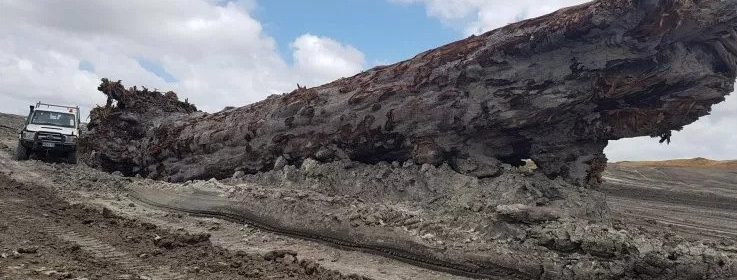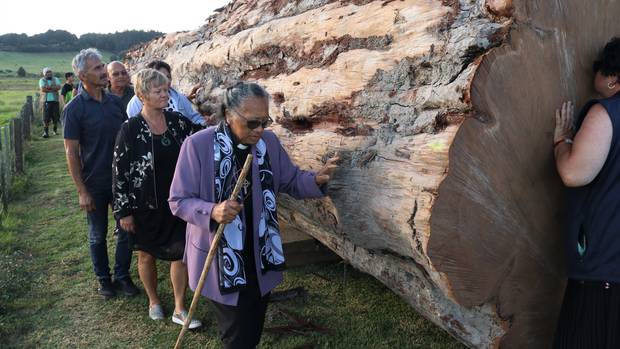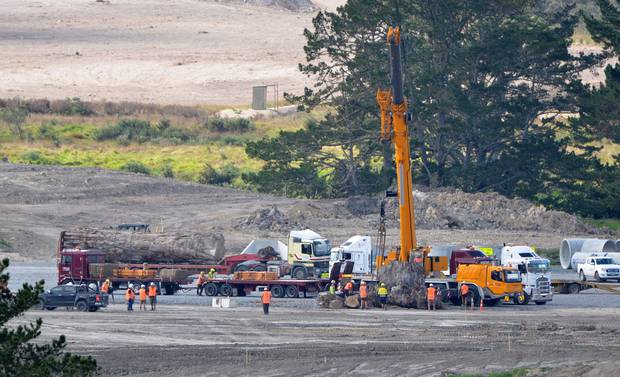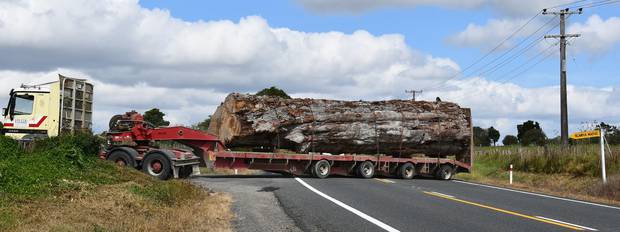Massive 60-tonne log over 40,000 years old is found buried underneath a New Zealand swamp – and it could help explain one of Earth’s biggest mysteries

An enormous Kauri swamp log unearthed by Kaikohe is around 40,500 years old and could bring new light on a mysterious global event that might have had a dramatic impact on the climate of the planet.

During excavation for a new geothermal power station near Ngāwhā Springs the log, which is 16 m long and weighs 60 tonnes, was found.
It was delivered by power company Top Power to Ngāwhā Marae on Wednesday in a big logistical operation.
Top Energy chief executive Russell Shaw told the hapū, Ngati Rangi, during the formal welcome and blessing it didn’t feel like a gift.
”It feels like it’s being returned to its rightful owners,” he said.

Project site manager Mike Ohs said during site works for the new power station the tree was found preserved in clay 9metre underground.
Sections about 1.5m long had to be cut off either end so it could be moved. The stump alone weighed 28 tonnes.
The three sections were lifted by crane then trucked about 5km along State Highway 12.
The operation started at about 8 am on Wednesday with the tree on the marae grounds by noon.
Ngāwhā Marae Trustees Komiti chairman Richard Woodman said no decision had been made yet about what to do with the raw (resource).
The carving was one possibility but there was a lot of talking to be done first.

The marae was open to sharing the rakau (tree) if other marae wanted some of it, and he was aware other hapū had questioned why it had been given to Ngāti Rangi.
”We definitely know that we’re not just going to keep it for ourselves,” he said.
Woodman said it was a ”fantastic acknowledgement” from Shaw that the tree was being returned rather than gifted.
The find has also sparked great excitement among scientists hoping to gain a better understanding of the ancient climate.
Alan Hogg, director of the Waikato Radiocarbon Dating Laboratory at Waikato University, dated the tree to 40,500 years plus or minus 400 years.
That made it of great interest to scientists studying the Laschamp Event, a ”magnetic reversal” in which the Earth’s north and south magnetic poles switched places.
It was not known exactly when the reversal occurred but it was thought to have been about 41,000 years ago.
Studying the level of radioactive carbon-14 in the Ngāwhā kauri’s rings would allow scientists to pinpoint more accurately when the reversal occurred and for how long.
Until now no tree had been found anywhere covering this later period of the reversal, Hogg said.

One of the reasons scientists were interested in magnetic reversals — and the accompanying drop in the Earth’s magnetic field strength, which allowed more solar radiation to reach the Earth’s surface — was that they could have a major effect on climate.
”So this tree is critical, we’ve never found one of this age before. We’re very excited and incredibly grateful to Ngāwhā Marae for allowing us to take samples.”
Going by its size the tree was likely to have been 1500-2000 years old when it died, Hogg said.
Despite the scale of the excavations at Ngāwhā — about 900,000cu m in total — Shaw said only one tree had been uncovered so far.
The company had also consulted the Northland Regional Council and the Ministry for Primary Industries about the find.
The tree found at Ngāwhā was part of a vast kauri forest which cloaked the upper North Island before the arrival of humans. Deforestation accelerated rapidly around 1820 after the arrival of Europeans. It is estimated that only 4 per cent of the original forest remains.
Top Energy’s relationship with Ngāti Rangi had developed during the consenting process for the power station, Shaw said.

Earthworks for the new power station started in 2017 and are due to be completed in July.
When the 28MW power plant is built, scheduled for late 2020, it will more than double the Far North’s energy production to 53MW.
If a third power plant is built as planned, output will reach 81MW, making the Far North a net energy exporter.